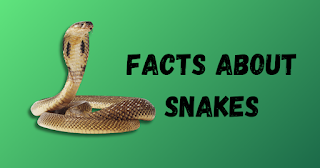Facts About Snakes
1. Biodiversity:
With the exception of extremely cold areas like the Arctic and Antarctica, snakes are a highly diverse group of reptiles, with over 3,000 species found in a wide range of environments worldwide.
2. Body Structure:
An elongated, legless reptile, snakes have a flexible body shape that enables them to move in a multitude of ways. To slither and climb, they make use of their muscles and scales.
3. Scales:
A snake's scales make up its outermost layer. These scales have several uses, such as protection, lowering water loss, and facilitating mobility.
4. Poisonous and Non-Poisonous:
Not every snake has venom. As a matter of fact, most species of snakes are not poisonous. Specialized glands and fangs allow venomous snakes to inject their victims with venom.
5. Types of Venom:
Poisonous snakes paralyze and consume their prey using venom. The effects of venom can differ greatly throughout species, ranging from hemotoxic venom that damages blood and tissues to neurotoxic venom that affects the neurological system.
6. Carnivorous Diet:
Since snakes are carnivores, their main sources of food are small creatures like rodents, birds, and insects. Because of their flexible jaws, certain giant snakes can eat prey that is much larger than their heads.
7. Distinctive Jaw Structure:
Snakes' jaws are made differently, which enables them to extend their mouths incredibly wide. They may ingest prey whole thanks to their flexibility.
8. Heat-Sensing Pits:
Heat-sensing pits on the skulls of many pit vipers and several other snake species enable them to sense heat from warm-blooded prey in the dark.
9. Reproduction:
There are several ways that snakes reproduce. Oviparous snakes lay eggs, viviparous snakes give birth to live offspring, and ovoviviparous snakes use a combination of the two.
10. Lifespan:
Snakes are known to have lengthy lives; several species have been known to live for several decades in the wild and much longer in captivity.
11. Skin Shedding:
The process by which snakes periodically lose skin is known as ecdysis. This aids in their growth, removal of parasites, and replacement of old, damaged skin.
12. Habitat Adaptations:
From deserts to rainforests, snakes have the ability to adapt to a variety of environments. While some live in trees, others are fossorial, or burrowing.
13. Nocturnal and Diurnal:
The habits of many snake species differ. While some are mostly diurnal (active during the day), others are nocturnal (active at night).
14. Conservation Challenges:
The delusion that snakes are deadly, habitat degradation, and poaching for the pet trade pose threats to many snake species. The persecution of certain species by humans also puts them in danger.
15. Ecological Role:
As both predators and prey, snakes have significant ecological roles. They support the equilibrium of ecosystems by assisting in the management of rodent and other small animal populations.
In conclusion, snakes are amazing reptiles that exhibit a diverse range of behaviours, adaptations, and ecological responsibilities. The majority of snake species are benign and perform important roles in the natural world, yet some are venomous and perhaps harmful. For their conservation and appreciation, it is crucial to comprehend their biology and ecological importance.






0 Comments